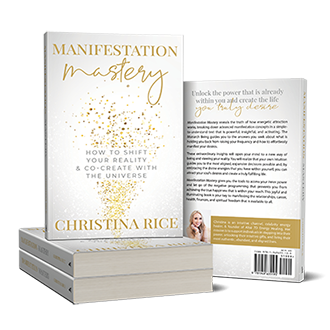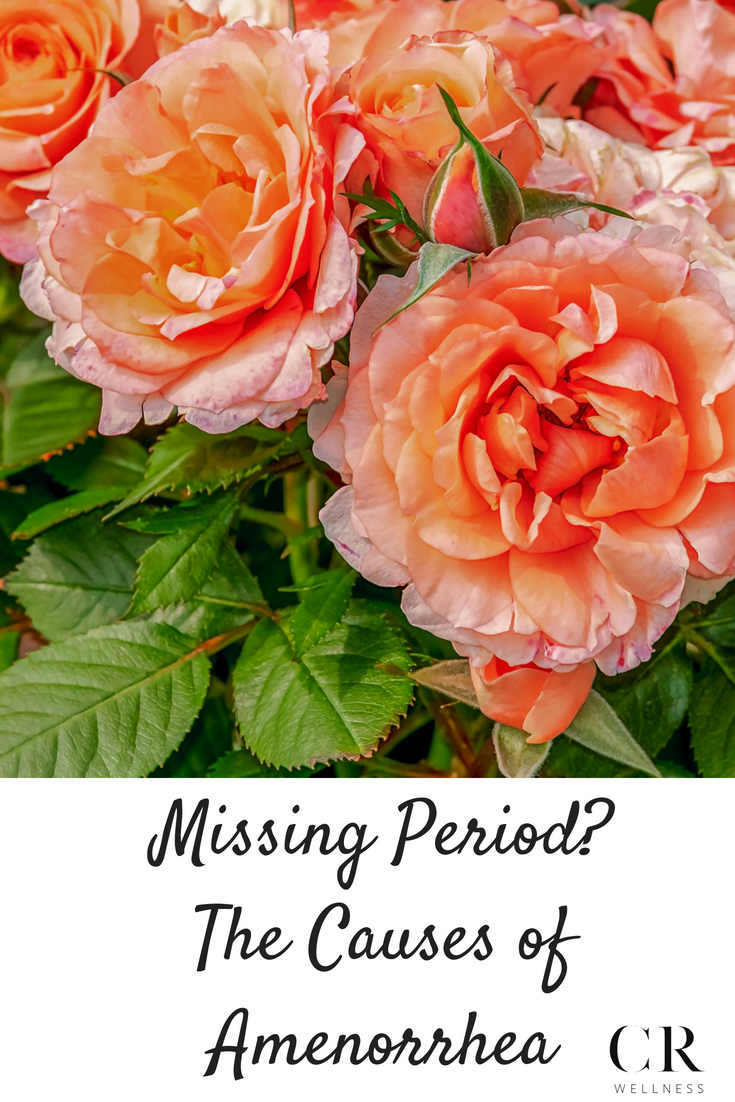Recently on Instagram I asked what health topics you’d like me to talk more about, and an overwhelming number of people asked for more about amenorrhea. Ask and you shall receive – there is a lot to say about amenorrhea, and it’s something I see regularly with clients. I’ve already written a post about the unfortunate current epidemic of amenorrhea and its normalization in our society, but I want to do a few posts taking a step back and covering all of the basics when it comes to amenorrhea – what causes it, why you should care, and steps to address it.
The majority of women I speak to either have it or have had it, and that’s not only in working with clients. That’s just in speaking to women regularly – clients, family, friends, and acquaintances. This is affecting more women than we think. In this post, I’m going to focus on what the causes of amenorrhea are. Remember, this information is for educational purposes only and is not meant for diagnosis or treatment. Check in with your healthcare practitioner to learn more about YOUR specific health situation.
What is amenorrhea?
Amenorrhea refers to a lack of period. For women, having a regular monthly period is a key indicator of health – probably the easiest marker of our overall health for us to track. We were designed to reproduce and pass on our genes, but the female body will stop its menstrual cycle if something is threatening its health. The body’s main priority will always be survival, and reproduction will be put on the back burner if survival is threatened. Gotta run away from the tiger or fight the infection first – if you’re dealing with that, it’s not the right time to even have a baby because the baby’s survival will be at risk! Reproduction is stopped until the threat to our health is addressed and our body feels safe enough to create and support a child. Whether or not you want a child, this is how your body is designed to respond.
There are many possible causes of amenorrhea, and it’s important to figure out what YOUR cause is so that you can make sure you’ve addressed the root problem, and also so that later on in your life you don’t suffer the longterm health consequences of not having a period. Some of the possible reasons why your period might be missing are due to Post-Birth Control Syndrome (effects of getting off birth control), HPA axis dysregulation, high stress in general, primary ovarian insufficiency (early menopause), low bodyweight, overexercising, traumatic brain injuries, ovarian cancer, PCOS (Polycystic Ovarian Syndrome), malabsorption from gut disorders like Celiac or IBD, pituitary tumors, thyroid disease, and of course pregnancy and menopause. As you can see, those are all over the board, and this is clearly not an exhaustive list. Some of those potential causes might worry you more than others, but they should all worry you unless you’re pregnant or going through menopause (pretty sure all of us expect our periods to stop during those times). Not having a period is not healthy (again, unless you’re pregnant or menopausal), and amenorrhea indicates there is something else in your life that needs to be addressed.
I also want to note that if you are on hormonal birth control, you don’t know what the actual state of your period is. “Periods” while you’re on hormonal birth control are “fake bleeds.” You won’t know whether or not you have a regular cycle, or amenorrhea, unless you’re off of hormonal birth control so that your body can show you its natural state. For example, a few years ago I was very sick, at an incredibly low body fat percentage, severely hypothyroid, and not producing any sex hormones on my own according to blood tests. However, I still had a “period bleed” every month. This was not a real period – it was because I was still on the birth control pill. It wasn’t until I got off the pill that my body showed me it actually had amenorrhea, which then allowed me to see that I needed to address the underlying causes.
How do our cycles even work?
Understanding how the normal menstrual cycle works can help us understand what happens when things go wrong with our periods. The hypothalamus is the part of the brain that links the nervous system to the endocrine system. The hypothalamus and pituitary gland are best buddies – the hypothalamus sends signals to the pituitary telling it whether or not it should create certain hormones that affect the rest of the body. For a woman with a normal menstrual cycle, certain hormone levels in the blood will encourage the hypothalamus to release something called Gonadotropin Releasing Hormone (GnRH). GnRH tells the pituitary gland to go ahead and release gonadotropins – FSH (follicle stimulating hormone) and LH (luteinizing hormone).
FSH and LH are hormones that communicate with the ovaries and tell them to produce and secrete sex hormones, like estrogen and progesterone, at the proper times in our cycles. It’s not that we just need these hormones to be produced and secreted – we also need the right amounts in order for our ovaries to do their jobs prperly. FSH is released in the first part of the menstrual cycle and encourages egg development. LH is released in the second part of our cycle and helps the endometrium lining get ready to be shed. In order for FSH and LH to work properly, our HPA axis needs to be functioning correctly as well. To recap – our ovaries produce the follicles and the eggs, and they also produce estrogen and progesterone. The amount of estrogen and progesterone in our blood changes throughout the month, and that change tells the hypothalamus when to release FSH and LH, and we are back to where we started. See why it’s called a cycle?
Hormonal Changes that Can Lead to Amenorrhea
Amenorrhea can occur as a result of that delicate balance of hormones getting thrown off. There are a few different types of hormonal imbalances that can lead to irregular menstruation, so let’s talk about a few possibilities on the hormonal level.
First, if we have low levels of estrogen, then the pituitary doesn’t release FSH or LH, leading to problems with the menstrual cycle.
High levels of testosterone can also have an impact on estrogen levels, which then affects related hormones and bodily processes.
Next, low levels of leptin (typically called the satiety hormone) can also cause the pituitary to not secrete FSH or LH. If leptin is low, then the hypothalamus thinks the body is in a state of starvation. If the body perceives a lack of energy, the hypothalamus stops reproductive function. Leptin levels decrease as body fat decreases. Therefore, leptin levels might be low because of low body fat, or they can be perceived as being low if someone is leptin resistant. Leptin resistance occurs more often in overweight women, when the body learns to become insensitive to leptin signaling.
Lastly, high stress levels and therefore high cortisol levels can stop the hypothalamus and pituitary from releasing the hormones necessary to have a period.
While there are a wide variety of causes of amenorrhea, many of which are very intertwined, stress is at the root of most cases. That can be emotional stress, mental stress, physical stress, internal stress, external stress, perceived stress, hidden stress – any type of stress.
Hypothalamic Amenorrhea
Hypothalamic Amenorrhea (HA) is the health condition I see most often in particular, as it unfortunately affects many women in their late teens, twenties, and early thirties. Much of this is because of the “health norms” of modern culture – health norms that are actually putting many women’s health at risk rather than supporting it. HA is commonly seen in women who have a history of emotional stress, gut issues, undereating, and overtraining.
When someone is struggling with hypothalamic amenorrhea, then GnRH isn’t secreted like it should be due to stress, low body fat, undereating, or some type of low energy availability. Without enough GnRH, the ovaries don’t get the message to make sex hormones, and the body doesn’t menstruate.
The Female Athlete Triad
HA is also related to something called the Female Athlete Triad. There are three parts of the Female Athlete Triad – menstrual problems (irregular cycles or amenorrhea), low energy availability (this can be due to an eating disorder or can occur without an eating disorder), and low bone mineral density (related to or leading to osteoporosis and osteopenia). HA is common in athletes or women who exercise often and have low levels of body fat, and the Female Athlete Triad is a term that refers to three interrelated conditions that tend to come together in this population of women. Because these three often go hand in hand, if a female athlete is presenting with one of the conditions, it’s important to check on the other two.
More on the causes of Amenorrhea…
First of all, I want to differentiate between PCOS and HA. Many women with PCOS (Polycystic Ovarian Syndrome) have irregular periods or amenorrhea, and this is usually related to insulin resistance and elevated androgen levels. HA, on the other hand, is more related to a woman not having enough energy availability – typically from undereating, overexercising, or both. They are often mistaken for each other, but they are different. That being said, PCOS can become HA if a woman with PCOS isn’t eating enough or is overtraining.
I briefly went over a long list of potential causes of amenorrhea, but I want to highlight some of the most common underlying causes of amenorrhea that I see.
- Chronic stress. Almost every point that follows this is related to the issue of chronic stress. If our bodies are stressed out and releasing too much cortisol, this can halt reproduction. When cortisol is too high, this can decrease the secretion of GnRH from the hypothalamus, which then leads to low levels of FSH and LH. Low FSH and LH will then lead to low estrogen, testosterone, and progesterone. Low sex hormones can lead to amenorrhea. This is related to HPA axis dysregulation, an issue that leads to a myriad of other health concerns in addition to amenorrhea.
When I’m talking about chronic stress, this includes every type of stressor. This could be stress from work, school, where you live, your partner, an annoying friend, or kids. It could be stress from undereating or overtraining. It could be emotional stress from fear of the future. It could be stress from another underlying health condition, like an underlying infection or hormonal issue that hasn’t been treated. It could be stress from not getting enough sleep at night (this is common). It could even be stress from environmental toxins and toxic personal care products. Anything that stresses the body out emotionally, mentally, or physically, whether or not you actively recognize it as “stress” (many women struggle with chronic stress but have gotten used to it so don’t realize it), can lead to amenorrhea. Many of the following points will be types of chronic stressors. - Not eating enough food. A large number of women are undereating calories, especially women on whole-food diets. Many are still stuck in diet culture, have some idea of how many calories they think they should be eating, or are afraid of eating a larger volume of food. Your body needs a certain number of calories each day to perform its daily functions – don’t try to outsmart it. If you’re active, you probably need more calories. A low calorie diet puts the woman in an energy deficit and stresses the body – the hypothalamus doesn’t like this. When you don’t eat enough calories, this creates a starvation response in the hypothalamus, which will then shut down the secretion of the hormones needed for ovulation.
- Overtraining. Overexercising is another major stressor on the body. Cardio, in particular, is the main type of exercise that most women seem to overdo. Again, the amount of exercise that is “too much” is different for every woman. Some women might be able to workout 5 or 6 days a week with no problems, and others might only be able to do 2 or 3. Likewise, different women can tolerate different types of training. Maybe running stops your period, but pilates doesn’t.
Overtraining can lead to amenorrhea for a few reasons. Overexercising can lead to a chronically high stress response (cortisol release), it can decrease leptin signaling, it can create an energy deficit the body doesn’t like, and it can lead to lower body fat levels that the body might interpret as starvation. If a woman is burning too many calories, especially when the body is also under other emotional and physical stressors, the body is going to stop reproduction and reserve energy for the functions necessary for survival. - Not having enough body fat. This is a tough one for many women to accept, and it’s tied in with overexercising and undereating. Many women find that when their body fat gets below a certain number, their period stops. When their body fat goes up a little, it starts again. This is because estrogen and leptin are produced in fat cells, and as previously mentioned, a certain amount of these hormones is needed in the blood for the hypothalamus to move forward with the normal cascade of reproductive hormones. Without enough body fat, and therefore without enough estrogen and leptin, menstruation will stop. The amount of body fat your body needs to properly menstruate is going to be different for every woman. This is particularly difficult for women who have a specific “goal” body fat percentage and realize that at that body fat level, their period stops. This is why we throw societal standards and arbitrary “ideals” out the window and start listening to our bodies.
- Weight loss, especially when it happens quickly. Weight loss is related to the first three points. If you lose weight and reach a weight that is below that which your body wants in order to feel “safe,” menstruation will stop. This seems to be a bigger issue for people who lose weight very quickly, rather than those who lose weight over a longer period of time. When the body is used to running off of a certain weight and then your weight drops very suddenly, the body is more likely to think it’s starving. Another interesting point is that the female reproductive system learns to run on the nutrient stores she has when she is younger. If a girl has a higher body fat percentage at a younger age, then her hypothalamus gets used to sending signals to the ovaries based on the amount of estrogen produced from that amount of fat cells. This is why some women can be very thin their whole lives and never deal with fertility issues related to low bodyweight, whereas women who lose a lot of weight might be more likely to lose their periods. Again, every woman is different, and every woman is going to have a unique body fat percentage that her body doesn’t want to go below.
- Not eating enough carbohydrates. This is a very controversial one, and you’ll see a lot of people in the keto space arguing against this. This is my professional opinion based on what I see in practice and what I have read and studied myself. I think that every woman has a different level of carbohydrates her body needs to function properly. Some women can be really low carb and be totally fine, and others will lose their periods from going too low in carbohydrates. In general, though, women do need more carbohydrates than men. Sorry, but it’s true. It’s easier for the male body to run off of less carbs.
That being said, I see many women who go low carb also lose their periods. This is also a side effect that is seen in studies looking at the health effects of keto, but it’s never really highlighted because it wasn’t the purpose of the study. Many people in the keto space argue that it is the lack of calories, not the lack of carbohydrates, causing women to lose their periods. This might be true for some women, but there are plenty of women for which it is the carbohydrates specifically that are needed. Even if they’re getting enough calories, they might still have amenorrhea without enough carbs – and I’m talking about starches and fruit. This is why carb-ups are often important for women who are following a keto approach and dealing with hormonal issues, or why keto simply might not work for you.
Carbohydrates support the conversion of T4 into T3, the active form of the thyroid hormone, in the liver. Even though the liver can produce its own glycogen, the body can get worn out from doing this for too long, especially when a woman is already dealing with any other stressors. Carbs can also help to spike leptin levels because rises in insulin also raise leptin, so carbs let the hypothalamus know that we are being fed. - Hypothyroidism, which can also be related to eating too little carbs. Without enough T3, the body can’t produce enough estrogen or create follicles, and then the woman can’t reproduce. Low thyroid can be a main cause of ovarian malfunction, because the reproductive organs are often the first organs affected when T3 is too low.
- Low-fat diets or bad-fat diets. Our bodies need healthy fats to create hormones, so your body isn’t even going to make the hormones needed for a proper menstrual cycle if you don’t eat enough healthy fats. Also, diets that are comprised of unhealthy fats can also lead to hormone issues. Unhealthy polyunsaturated fats can be highly unstable and oxidize in the body, creating inflammation. Plus, you don’t want your body trying to make hormones out of broken, rancid fats. This is why it’s important to avoid unhealthy fats like vegetable oil, peanut oil, canola oil, soybean oil, and margarine.
- High-dairy diet. Dairy is filled with hormones, even when it’s organic dairy from pasture-raised cows. Dairy is very androgenic and can increase levels of testosterone in the body. This is an even bigger issue for anyone eating conventional dairy, which contains added hormones and toxins. While well-sourced dairy might not be an issue for everyone, any women who are struggling to regulate their cycle should consider removing dairy from their diets. Going back to the problems with conventional sources of dairy – that is also why it’s important to avoid conventional sources of eggs, meats, and other animal products. Their hormone levels can affect yours.
- Phytoestrogens. Hormones from food are not as strong as hormones created in our own bodies, but they can still affect someone who has weakened reproductive function. For people without health issues, this isn’t as much of a problem. Phytoestrogens are plant estrogens that look like estrogen but aren’t exactly the same, and they are typically found in legumes, nuts, and seeds. Soy is the most powerful, and should be avoided in general. This is another reason why it’s important to pay attention to the sourcing of your food – if you’re eating animal products from animals that were fed soy, your diet is higher in soy, too. Sometimes phytoestrogens help people who have symptoms of low estrogen, but because it’s not real estrogen, it can still create problems if “real” estrogen isn’t there to set off the rest of the hormonal cascade in the body.
- Getting off of birth control. Being on hormonal birth control can downregulate your body’s production of its own natural hormones, which is why many women who get off the pill realize they aren’t menstruating on their own. Sometimes the body just needs time to get back on track and start producing enough hormones again, but sometimes time isn’t enough and there’s more that needs to be done. For more on the side effects of hormonal birth control, click here.
- SIBO and other underlying gut infections. I find that many women can’t get their periods back until they address any gut dysbiosis, which creates a stressful state in the body. Not only is the dysbiosis itself causing underlying stress in the body, but oftentimes women who have gut issues undereat calories or carbohydrates because too much food or too many carbohydrates worsens their symptoms. This is why it’s so important to address any underlying gut health issues if you have irregular cycles.
While I’ve offered many different potential causes of amenorrhea, many of them are related. At the end of the day, though, stress, undereating, overexercising, and having too little body fat are typically at the root of it and definitely the most common causes I see. This can be difficult for many women to accept due to societal pressures and the unrealistic standards we are subjected to.
When it comes to amenorrhea, your body is not betraying you. Your body is responding in the way that it needs to for survival – it wants to protect you. For a cavewoman, not having access to food for months at a time or being stressed out from the lion circling her cave were legitimate stressors that would warrant stopping reproduction. You don’t want to be reproducing with those threats around – your baby wouldn’t survive! Nowadays, though, modern stressors that don’t seem as “serious” as a lion attacking us still elicit the same response from our bodies. Our bodies can’t tell the difference – stress is stress.
If you’re struggling with amenorrhea, check with your healthcare practitioner to see if any of the previously mentioned causes might apply to you.
Have more amenorrhea questions? Let me know!














Get Updates
And Goodies
We’re over fake “wellness.” It’s time to unlock your magic & magnetism. Are you ready to vibe higher?
Are you ready to finally optimize your health habits for real results and true health?